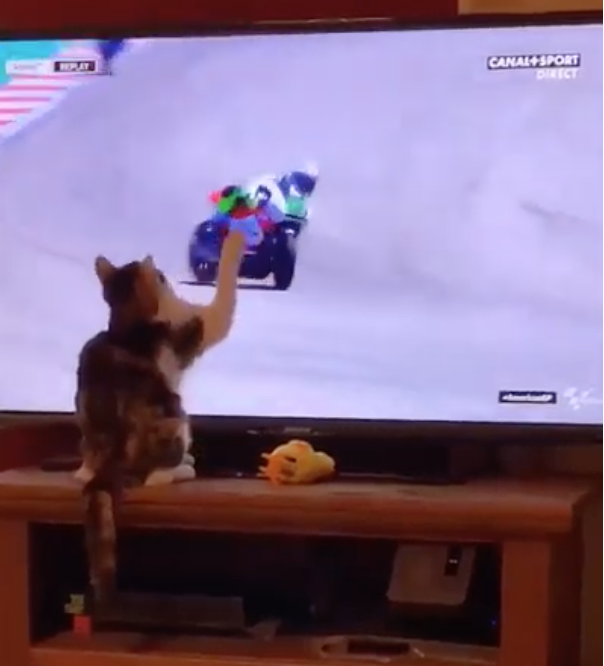

Don’t push her off, don’t scold, don’t make eye contact, just totally shun her. Don’t push her with your hands, and totally ignore her. If she does go too far and bite or swat, put her on the floor – again, by gently standing up. Gently, slowly stand up and she’ll leap down. Send her to the floor – but don’t touch her because she’s building up to a snap. Now that you know what to watch for, end the petting sessions before she’s had enough. Now, that’s behavior modification for you – but I know that you want to change her behavior, too. Also, the closer you are to the back of the head, the harder it is to whip around and bite you. Many cats get more sensitive toward their tails – you may have seen a cat who would stick his rump in the air if you petted him at the base of the tail – that’s a high stimulation spot.
CAT SWIPES FULL
Stay away from full body petting – you may get there eventually, but don’t try it in the beginning. When you do touch her, concentrate on her head, the sides of her face, and the back of her neck. It’s like someone one time said to me after watching the Amityville Horror – you know, when your house tells you “get out…” Get Out! When the cat tells you she’s done – leave her be.
CAT SWIPES SKIN
If a ridge stands up – or her skin ripples – the cat is also telling you, in cat-speak, she’s done. Watch also the fur along the back and the back of the head. When they dilate, the stimulation tank is full. Also, watch the eyes, A calm, relaxed cat’s pupils will be narrow. When the whole tail becomes involved, swishing back and forth – that’s a warning. Cats give a slow flick of just the tip of the tail. Dogs beat their tails back and forth when they’re happy. When a cat becomes overstimulated from petting, she is actually telling you that she’s had enough – if you speak her language. Understanding how cats communicateīefore we talk about changing feline biting behavior, though, you need a little Urdu to French translation. And that’s another difference between the species – discipline that works on a dog – is the wrong approach for a cat. Cats, on the other hand, to change their behaviors, you have to convince them that they want to change.

Dogs, they’ll modify their behavior because they want to please you. And, you have to understand how they tick, if you’re going to change their behavior. Cats… the sensitive ones… have a threshold. You can pet a dog, all day, and he’ll only bite you if you stop. One of the intriguing things about cats is that they’re not dogs. And it’s not surprising that fosters and owners are surprised when the affectionate cat suddenly snaps and takes a bite out of the hand they love… The ones that exhibit petting aggression – they’re usually the friendly ones, the ones that seek out petting. The extremely ticklish cats, they’re the exception, too. He’s a limp dishrag when you handle him, and he loves it. Those are the ones you can roll over and give belly rubs to. Those not-very-ticklish cats, they’re the exception. Eventually, what would you do – if he weighed 10 times what you did and you couldn’t get away? Right. And because he didn’t understand, he wouldn’t stop. You’d be screaming “stop, stop,” right? Well, imagine now that you only spoke Urdu, but your tickler spoke only French.

Imagine that you were incredibly ticklish, and that someone – for the sake of argument, someone you even liked a lot – wouldn’t stop tickling you. For some cats, however, their whiskers are ultra sensitive, and not just on their faces but everywhere. Just as some people aren’t ticklish, some cats aren’t particularly sensitive about their whiskers, or about being touched. What people don’t realize is that while the muzzle contains the greatest number of whiskers, cats actually have them all over their bodies, on their paws, head, back… They’re smaller and finer, so not as easily seen, but if you look closely, they’re there. Most people know how sensitive a cat’s whiskers are, and wouldn’t be rough with that spot on their faces.

It’s not really aggressive – nor is it mean, nor is the intent to actually hurt someone. I can’t tell you how often I hear “why does my cat attack me?” Let’s start with full disclosure – I have a cat with “petting aggression.” “Aggression” isn’t really the right word, though that’s what it’s generally called. It finally took Jackson Galaxy’s My Cat From Hell on Animal Planet doing an episode where every cat bit his or her person, for me to see the, ah, cat scratches on the wall. Then I worked with the adopter who had the same issue. I spent even more time counseling the second foster. I spent some time counseling the first foster about why his cat was biting him. This stuff always seems to come in clusters.


 0 kommentar(er)
0 kommentar(er)
